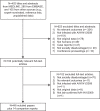Impact of H1N1 on socially disadvantaged populations: systematic review
- PMID: 22761796
- PMCID: PMC3382581
- DOI: 10.1371/journal.pone.0039437
Impact of H1N1 on socially disadvantaged populations: systematic review
Abstract
Background: The burden of H1N1 among socially disadvantaged populations is unclear. We aimed to synthesize hospitalization, severe illness, and mortality data associated with pandemic A/H1N1/2009 among socially disadvantaged populations.
Methods/principal findings: Studies were identified through searching MEDLINE, EMBASE, scanning reference lists, and contacting experts. Studies reporting hospitalization, severe illness, and mortality attributable to laboratory-confirmed 2009 H1N1 pandemic among socially disadvantaged populations (e.g., ethnic minorities, low-income or lower-middle-income economy countries [LIC/LMIC]) were included. Two independent reviewers conducted screening, data abstraction, and quality appraisal (Newcastle Ottawa Scale). Random effects meta-analysis was conducted using SAS and Review Manager.
Conclusions/significance: Sixty-two studies including 44,777 patients were included after screening 787 citations and 164 full-text articles. The prevalence of hospitalization for H1N1 ranged from 17-87% in high-income economy countries (HIC) and 11-45% in LIC/LMIC. Of those hospitalized, the prevalence of intensive care unit (ICU) admission and mortality was 6-76% and 1-25% in HIC; and 30% and 8-15%, in LIC/LMIC, respectively. There were significantly more hospitalizations among ethnic minorities versus non-ethnic minorities in two studies conducted in North America (1,313 patients, OR 2.26 [95% CI: 1.53-3.32]). There were no differences in ICU admissions (n = 8 studies, 15,352 patients, OR 0.84 [0.69-1.02]) or deaths (n = 6 studies, 14,757 patients, OR 0.85 [95% CI: 0.73-1.01]) among hospitalized patients in HIC. Sub-group analysis indicated that the meta-analysis results were not likely affected by confounding. Overall, the prevalence of hospitalization, severe illness, and mortality due to H1N1 was high for ethnic minorities in HIC and individuals from LIC/LMIC. However, our results suggest that there were little differences in the proportion of hospitalization, severe illness, and mortality between ethnic minorities and non-ethnic minorities living in HIC.
Conflict of interest statement
Figures




References
-
- Lai PL, Panatto D, Ansaldi F, Canepa P, Amicizia D. Burden of the 1999–2008 seasonal influenza epidemics in Italy: comparison with the H1N1v (A/California/07/09) pandemic. Hum Vaccin. 2011;7 - PubMed
-
- Higgins AM, Pettila V, Harris AH, Bailey M, Lipman J. The critical care costs of the influenza A/H1N1 2009 pandemic in Australia and New Zealand. Anaesth Intensive Care. 2011;39:391. - PubMed
-
- Falagas ME, Koletsi PK, Baskouta E, Rafailidis PI, Dimopoulos G. Pandemic A(H1N1) 2009 influenza: review of the Southern Hemisphere experience. Epidemiol Infect. 2011;139:40. - PubMed
Publication types
MeSH terms
Grants and funding
LinkOut - more resources
Full Text Sources
Medical

